Cat in the box

Cat in the box
ã‚ャットインザボックス (Cat in the Box) is a trick-taking card game from Japan, based upon ideas from quantum mechanics. Players play cards from their hands of different values. But the colour of the card is not determined until the card is played, and the cat is let out of the box.
Played over three rounds for three players, and four rounds for four, players begin by making a bid on the number of tricks they will win, based only upon the value of their hand cards. The cats on the cards have no colour at this point. Players will score for tricks they win, and score more for completing their bid.
As a player leads with a card from their hand, they declare its colour. A player's marker goes onto the communal research board, covering the value for that colour. Subsequent cards must have different values of the same colour if possible. However, a player may declare that they do not have any more cards of that colour, and so play the same value but in a different colour. That player now marks their own board for Do Not Have in that colour.
The highest card of the colour lead wins the trick, unless a card is declared as red, the trump colour.
Crucially, all cards values and colours played out must be unique, otherwise a paradox is formed, ending the round.
So if a player is holding a 1,3,6, and yellow is lead, and only the yellow 1 remains open on the research board, the player is forced to play their 1 card as a yellow. But if that player has already claimed they Do Not Have yellow (as above), and if the other colours are also blocked on 1, 3 and 6, this causes a paradox. They cannot play, thus ending the round and triggering a scoring.
The player causing the paradox does not score and incurs penalty points also.
Scores are accumulated over the rounds, and the player with the highest total at the end is the winner.
Players must balance trying to win tricks to their bid with avoiding forming a paradox, forcing the round to end and incurring penalties.
user summary
Played over three rounds for three players, and four rounds for four, players begin by making a bid on the number of tricks they will win, based only upon the value of their hand cards. The cats on the cards have no colour at this point. Players will score for tricks they win, and score more for completing their bid.
As a player leads with a card from their hand, they declare its colour. A player's marker goes onto the communal research board, covering the value for that colour. Subsequent cards must have different values of the same colour if possible. However, a player may declare that they do not have any more cards of that colour, and so play the same value but in a different colour. That player now marks their own board for Do Not Have in that colour.
The highest card of the colour lead wins the trick, unless a card is declared as red, the trump colour.
Crucially, all cards values and colours played out must be unique, otherwise a paradox is formed, ending the round.
So if a player is holding a 1,3,6, and yellow is lead, and only the yellow 1 remains open on the research board, the player is forced to play their 1 card as a yellow. But if that player has already claimed they Do Not Have yellow (as above), and if the other colours are also blocked on 1, 3 and 6, this causes a paradox. They cannot play, thus ending the round and triggering a scoring.
The player causing the paradox does not score and incurs penalty points also.
Scores are accumulated over the rounds, and the player with the highest total at the end is the winner.
Players must balance trying to win tricks to their bid with avoiding forming a paradox, forcing the round to end and incurring penalties.
user summary
Player Count
3
-
4
Playing Time
30
-
45
Age
10
Year Released
2020
Newest Review
Remote video URL